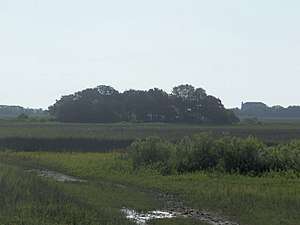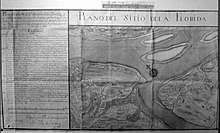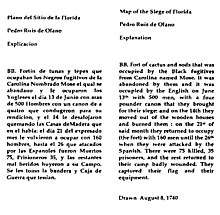Fort Mose Historic State Park
Fort Mose Historic State Park (originally known as Gracia Real de Santa Teresa de Mose[3]) is a U.S. National Historic Landmark (designated as such on October 12, 1994),[2] located two miles north of St. Augustine, Florida, on the edge of a salt marsh on the western side of the waterway separating the mainland from the coastal barrier islands. The original site of the 18th-century fort was uncovered in a 1986 archeological dig. The 24-acre (9.7 ha) site is now protected as a Florida State Park, administered through the Anastasia State Recreation Area. Fort Mose is the "premier site on the Florida Black Heritage Trail".[4] In 1738, the Spanish governor of Florida, Manuel de Montiano, had Fort Mose (pronounced [ˈmose]) built and established as a free black settlement, the first to be legally sanctioned in what would become the territory of the United States.[5] The fort has also been known as Fort Moosa or Fort Mossa, variants of the Spanish pronunciation.
Fort Mose Historic State Park | |
 Site of the old fort | |
| Location | St. Johns County, Florida, USA |
|---|---|
| Nearest city | St. Augustine, Florida |
| Coordinates | 29°55′40″N 81°19′31″W |
| Area | 24 acres (9.7 ha) |
| NRHP reference No. | 94001645[1] |
| Significant dates | |
| Added to NRHP | October 12, 1994[1] |
| Designated NHL | October 12, 1994[2] |
Historical background
As early as 1687, the Spanish government had begun to offer asylum to slaves from British colonies. In 1693, the Spanish Crown officially proclaimed that runaways would find freedom in Florida, in return for converting to Catholicism and a term for men of four years' military service to the Crown.[6] By 1742, Spain had effectively created a maroon settlement in Florida as a front-line defense against English attacks from the north. Spain also intended to destabilize the plantation economy of the British colonies by creating a free black community to attract slaves seeking escape and refuge from British slavery.[7]
Fort Mose


In 1738, Governor Montiano ordered construction of the Gracia Real de Santa Teresa de Mose military fort about 2 miles (3.2 km) north of St. Augustine. Slaves who had escaped from the British colonies were directed there. They were recognized as free, and men who passed inspection were taken into the Spanish militia and placed into service. The military leader at the fort, who also served as the de facto leader of the maroon community, was Francisco Menéndez, a Mandinga African born in the Gambia region along the Gambia River. He had been captured by slave traders and shipped to the colony of Carolina,[8] from where, he, like many other black slaves, escaped and sought refuge in Spanish Florida. He was appointed captain of the slave militia at St. Augustine in 1726 by Governor Antonio de Benavides, and reappointed to this position by each successive governor of the province.[9] His status as a leader was solidified with the Spanish authorities when he helped defend the city from an English attack led by Colonel John Palmer in 1728 and distinguished himself by his bravery.[10]
Fort Mose was the first free African settlement legally sanctioned in what would become the United States and had a total population of about 100.[5] The village had a wall around it, with dwellings inside, as well as a church and an earthen fort. Menéndez was freed by Governor Montiano in 1738, on the condition that he convert to the Catholic faith, and baptized as "Francisco Menéndez".
Hundreds of thousands of enslaved Africans were imported in the 18th century to the Carolinas, where their labor was essential to the plantation economy. Word of the settlement of free blacks at Mose reached the colonies of South Carolina and Georgia, and attracted escaping slaves. Fellow blacks and their Indian allies helped runaways flee southward to Florida. The Spanish colony needed skilled laborers, and the freedmen strengthened St. Augustine's military forces. In 1738 the Spanish governor established the runaways in their own fortified town (officially known as Gracia Real de Santa Teresa de Mose, but usually referred to simply as "Mose" in governmental documents of the period). This administrative action followed the example of colonial governments in the Caribbean, enabling the Spanish to hold and populate territory threatened by the Carolinians.[11] The existence of Fort Mose is believed to have helped inspire the Stono Rebellion in September 1739.[12] This was led by slaves who were "fresh from Africa".[13] During the Stono revolt, several dozen Africans believed to be from the Kingdom of Kongo tried to reach Spanish Florida. Some were successful, and they rapidly adjusted to life there, as they were already baptized Catholics (Kongo was a Catholic nation) and spoke Portuguese.[12]
As a military outpost, Mose defended the northern approach to St. Augustine, the capital of La Florida. Most of its inhabitants came originally from numerous different tribal and cultural groups in West Africa (predominately Kongos, Carabalis, and Mandingos) and had been taken as slaves to the English provinces of North Carolina and South Carolina.[14] While struggling to make their way to freedom in Florida, they had frequent interactions with many Native American peoples. By successfully defending their freedom and Spanish Florida in the mid-18th century, the black inhabitants of Fort Mose had a significant role in contemporary political conflicts between England and Spain in the southeast.[15]
The people of Mose made political alliances with the Spaniards along with their Indian allies, and took up arms against their former masters. The black militia fought beside Spanish regular soldiers to drive away the English forces under Gen.James Oglethorpe who attacked St. Augustine in 1740; these black troops also fought in the Spanish counterattack against the Georgia colony in 1742. Following the murder of some inhabitants at the fort by Indian allies of the British, Montiano ordered it abandoned and its inhabitants resettled in St. Augustine. In 1740, British forces led by James Oglethorpe of Georgia attacked and captured the fort in the Siege of Fort Mose. During the ensuing conflict, a Floridian force consisting of Spanish troops, Indian auxiliaries, and free black militia counterattacked Oglethorpe's troops and defeated them decisively, destroying the fort in the process. Oglethorpe was eventually forced to withdraw his forces to Georgia. Because the fort was destroyed, its inhabitants stayed in St. Augustine. By 1752, the Spanish had rebuilt Fort Mose. The new governor forcibly relocated most of the free blacks back into the defensive settlement, from the more cosmopolitan, multilingual culture of St. Augustine.[16]
After East Florida was ceded to the British in the Peace of Paris (1763), most of the free black inhabitants emigrated to Cuba with the evacuating Spanish settlers.[17][18] At that time, the black population at St. Augustine and Fort Mose totaled about 3,000, of whom about three quarters were escaped slaves.[19]
A haven for refugee slaves from the British colonies to the north, Fort Mose is considered the "premier site on the Florida Black Heritage Trail".[4] The National Park Service highlights it as a precursor site of the Underground Railroad.[5] This was the network in the antebellum years preceding the American Civil War by which slaves escaped to freedom, most often to the North and Canada, but also to the Bahamas and Mexico.
Modern identification and recovery of the Fort Mose site
The site was abandoned when Spanish Florida became British in 1763. It was leveled by the British in 1812 and forgotten. In 1968, motivated by the recent (1963–1964) racial violence in St. Augustine (see St. Augustine Movement), Frederick Eugene "Jack" Williams, a long time St. Augustine resident, historian and amateur archaeologist, located the site from an old map, purchased the land, and began a campaign, supported by the Black Caucus in the Florida legislature, to have the site excavated.[20]
During 1986-1988 a team of specialists, the Fort Mose Research Team, led by Kathleen Deagan of the Florida Museum of Natural History and under the supervision of John Marron of the University of Florida, performed an archaeological and historical investigation at Fort Mose.[21] Their discoveries showed that Africans played important roles in the geopolitical conflicts between England and Spain in the southeast of what is now the United States.
Documents examined by historian Jane Landers in the colonial archives of Spain, Florida, Cuba, and South Carolina reveal who lived in Mose and some idea of what their lives were like in the settlement. In 1759 the village consisted of twenty-two palm thatched huts housing thirty-seven men, fifteen women, seven boys and eight girls. The people of Mose grew their own crops and their men stood guard at the fort or patrolled the frontier in service to the crown.[22] They attended Mass in a wooden chapel where their priest also lived. Most of them married other refugees, but some married Indian women or slaves who lived in St. Augustine.
In the first year of excavating the archaeologists uncovered remains of fort structures, including its moat, clay-daubed earthen walls and the wooden structures inside the walls. They found a wide assortment of artifacts: military paraphernalia such as gunflints, lead shot, metal buckles and hardware; household items such as pipestems, thimbles, nails, ceramics, and bottle glass;[23] and food remnants such as burnt seeds and bone.[24]
Fort Mose's location on the small tidal channel called Mose Creek (Caño Mose) gave the Mose settlers access to the estuarine mud flats, oyster bars, salt marshes, and other tidal creeks of the North River, which joins the Matanzas River to form Matanzas Bay, St. Augustine's harbor. This tidal estuary was a rich source of food. Analysis of faunal remains found at the site by the team zooarchaeologist Elizabeth Reitz indicated that the Mose villagers had a diet very similar to that of the nearby Indian communities, with a heavy dependence on marine proteins and wild foods.[25]
Park facilities
An archeological excavation in 1986, led by Kathleen A. Deagan and historian Jane Landers revealed the site of the original Fort Mose,[26] as well as the second facility constructed in 1752. Today, artifacts are displayed in the museum within the Visitor Center at the park. On the grounds, interpretive panels are used to illustrate the history of the site. Three replicas of historic items have been installed within the park: a choza or cooking hut, a small historic garden, and a small Spanish flat boat called a barca chata.
Children's book
The story of Fort Mose is told in a juvenile book published in 2010. It contains material not typically found in a children's book: an index, a long list of sources, internet resources, and documentation for all the illustrations.[27]
See also
References
| Library resources about Fort Mose Historic State Park |
- "National Register Information System". National Register of Historic Places. National Park Service. July 9, 2010.
- "Fort Mose Site". National Historic Landmark summary listing. National Park Service. 2008-06-20. Archived from the original on 2009-01-21.
- Kathleen A. Deagan (1 October 2014). "El Fuerte Mosé: Primera Comunidad Negra Libre". In Ann L; Henderson Gary R. Mormino; Carlos J. Cano (eds.). Spanish Pathways in Florida, 1492-1992: Caminos Españoles en La Florida, 1492-1992. Pineapple Press. p. 432. ISBN 978-1-56164-744-6.
- Darcie MacMahon; Kathleen Deagan (September–October 1996). "Legacy of Fort Mose - Archaeology Magazine Archive". Archaeology. 49 (5). Retrieved 20 July 2019.
- Aboard the Underground Railroad – Fort Mose Site, National Park Service
- Patrick Riordan (Summer 1996). "Finding Freedom in Florida: Native Peoples, African Americans, and Colonists, 1670-1816". The Florida Historical Quarterly. Florida Historical Society. 75 (1): 30.
- Peter Linebaugh; Marcus Rediker (2000). The Many-headed Hydra: Sailors, Slaves, Commoners, and the Hidden History of the Revolutionary Atlantic. Beacon Press. p. 205. ISBN 978-0-8070-5007-1.
- Jane Landers (3 October 2013). "The Atlantic Transformations of Francisco Menéndez". In Lisa A. Lindsay, John Wood Sweet (ed.). Biography and the Black Atlantic. University of Pennsylvania Press. p. 213. ISBN 978-0-8122-4546-2.
- Alan Gallay (11 June 2015). Colonial Wars of North America, 1512-1763 (Routledge Revivals): An Encyclopedia. Routledge. p. 435. ISBN 978-1-317-48719-7.
- Ira Berlin (July 2009). Many Thousands Gone: The First Two Centuries of Slavery in North America. Harvard University Press. p. 74. ISBN 978-0-674-02082-5.
- Jane Landers (22 October 1999). "Gracia Real de Santa Teresa de Mose: A Free Black Town in Spanish Colonial Florida". In Darlene Clark; Hine Earnestine L. Jenkins (eds.). A Question of Manhood, Volume 1: A Reader in U.S. Black Men's History and Masculinity, "Manhood Rights": The Construction of Black Male History and Manhood, 1750-1870. Indiana University Press. p. 91. ISBN 0-253-11247-8.
- Berlin 2009, p. 73
- Patrick Riordan (Summer 1996). "Finding Freedom in Florida: Native Peoples, African Americans, and Colonists, 1670-1816". The Florida Historical Quarterly. Florida Historical Society. 75 (1): 25.
- Jane Landers (22 October 1999). "Gracia Real de Santa Teresa de Mose: A Free Black Town in Spanish Colonial Florida". In Darlene Clark; Hine Earnestine L. Jenkins (eds.). A Question of Manhood, Volume 1: A Reader in U.S. Black Men's History and Masculinity, "Manhood Rights": The Construction of Black Male History and Manhood, 1750-1870. Indiana University Press. p. 104. ISBN 0-253-11247-8.
- Elizabeth J. Reitz (1994). "Zooarchaeological Analysis of a Free African Community: Gracia Real de Santa Teresa de Mose". Historical Archaeology. Springer. 28 (1): 24. doi:10.1007/BF03374179. ISSN 0440-9213.
- Berlin 2009, p. 76
- Jane Landers (1990). "Gracia Real de Santa Teresa de Mose: A Free Black Town in Spanish Colonial Florida". The American Historical Review. Oxford University Press. 95 (1): 29. doi:10.2307/2162952. ISSN 0002-8762. JSTOR 2162952.
- Kathleen A. Deagan; Darcie A. MacMahon (1995). Fort Mose: Colonial America's Black Fortress of Freedom. University Press of Florida. p. 17. ISBN 978-0-8130-1352-7.
- Berlin2009, p. 76
- McIver, Stuart (February 14, 1993). "Fort Mose's Call To Freedom. Florida's Little-known Underground Railroad Was the Escape Route Taken by Slaves Who Fled to the State in the 1700s and Established America's First Black Town". Sun-Sentinel. Retrieved February 10, 2018.
- Kathleen A. Deagan; Jane Landers (29 August 1999). "(13) Fort Mose: Earliest Free African-American Town in the United States". In Theresa A. Singleton (ed.). I, Too, Am America: Archaeological Studies of African-American Life. University of Virginia Press. p. 262. ISBN 978-0-8139-2916-3.
- Jane Landers (1999). Black Society in Spanish Florida. University of Illinois Press. p. 35. ISBN 978-0-252-06753-2.
- Kathleen A. Deagan; Jane Landers (29 August 1999). "(13) Fort Mose: Earliest Free African-American Town in the United States". In Theresa A. Singleton (ed.). I, Too, Am America: Archaeological Studies of African-American Life. University of Virginia Press. p. 272. ISBN 978-0-8139-2916-3.
- "Fort Mose: America's Black Colonial Fortress of Freedom". Florida Museum. University of Florida. 9 August 2017. Retrieved 27 July 2019.
- Jane Landers (1999). Black Society in Spanish Florida. University of Illinois Press. p. 55. ISBN 978-0-252-06753-2.
- Orser Jr., Charles E. (2016). Historical Archaeology. London, England: Routledge. pp. 151–152. ISBN 978-1-317-29707-9.
- Turner, Glennette Tilley (2010). Fort Mose and the Story of the Man who Built the First Free Black Settlement in Colonial America. Abrams Books for Young Readers. ISBN 9780810940567.
External links
| Wikimedia Commons has media related to Fort Mose Historic State Park. |
- Fort Mose Historic State Park at Florida State Parks
- Fort Mose Historic State Park, official website
- Fort Mose Historical Site, and Society
- History of Fort Mose, St. Augustine website
- St. Johns County listings, National Register of Historic Places
- St. Johns County listings, Florida's Office of Cultural and Historical Programs
- Fort Mose, National Park Service
- Fort Mose Site at The National Park Service – Links to the Past
- Fort Mose Historic State Park, Wildernet
- "Fort Mose: America's Black Colonial Fortress of Freedom", Florida Museum of Natural History
- Fort Mose – ThinkQuest
- "Fort Mose: A Legacy That Can Not Be Ignored", Blacksonville.com

